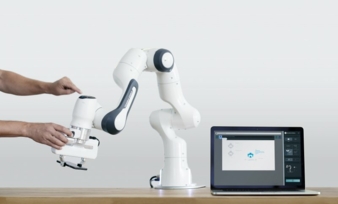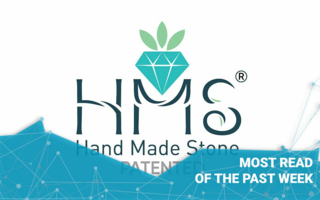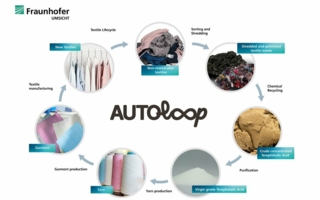26/03/2020 – Robotics in the textile industry – Part 2 — auf Deutsch lesen
Programming of industrial robots
No industrial robot is immediately ready to perform the tasks assigned to it after delivery. This requires programming the robot controller.
After Part 1 of the series dealt with the boundary conditions and current developments in robotics in the textile industry, this part now deals with the programming of industrial robots.
What is actually meant by the term “robot programming”?
Robot programming is the definition of the desired movements in position and orientation of the robot head so that the robot can perform them without human intervention. Basically, programming can be divided into online and offline methods. During online programming, there is a direct connection to the robot controller. For the programming activities, the robot must be taken out of the process, which results in an interruption of production. On the other hand, offline programming exists. The program can be created or modified by the robot independent of location.
The robot can still perform its current tasks. In practice, these two methods are mixed up. This way, the program can be created and prepared offline in the office, for example. After the transfer to the robot controller, it can be programmed online (also called teaching) in the next step and adapted to the exact conditions on site. The programming can be viewed on different levels: Due to the variety of sensor technology, e.g. camera systems, force-torque sensors, vision sensors, various interfaces, the degree of complexity and difficulty of programming increases.
Industrial robots were originally programmed in a textual syntax (programming language). Virtually every manufacturer has its own programming language with defined instruction sets. There are commands for movements as well as for controlling the periphery, e.g. the gripper. The knowledge of the specifics of the respective programming languages was previously reserved for highly specialized robot programming. These programmers have trained themselves intensively on a few robot manufacturers. High hourly rates and waiting times for their availability slow down the commissioning or reprogramming of robot systems. There is a recognizable trend that new methods are making the programming of industrial robots accessible to a larger circle of users.
A classic online procedure is teaching. The robot is moved to the desired position via single-axis buttons on the teach panel and the positions are stored. There are also different modes to perform the movements, e.g. the single axis movement (joint), linear or curved movements. They differ in accuracy and speed. A further method for faster commissioning is the demonstration or programming of motion sequences. The operator guides the robot through the desired motion sequence. The individual movements are stored and can be played back automatically afterwards. The robot can be guided via the teach panel or the manual guidance of the robot head. Further methods were developed by Wandelbots GmbH from Dresden.
Further methods
The movements are demonstrated with a jacket equipped with sensors or with the help of a sensor pen. A software generates the positioning commands which are transmitted to the robot. Robot manufacturers themselves and other companies have recognized the need for simplified programming and commissioning among customers. The features for simplified programming include the use of graphical programming interfaces, assistants and wizards, as well as the use of drag and drop functionalities, vendor independence and standard function blocks for certain activities. The graphical method is an alternative procedure to textual programming. Instead of creating textual process descriptions, blocks can be placed and interconnected in a graphical development environment. Especially for beginners in robot programming, this offers easy and fast access. An example of this is the programming interface of the manufacturer Franka Emika GmbH, Munich, in which the program blocks are placed together like a puzzle. If robots are to be controlled in a laboratory environment, the LabView graphical programming system from National Instruments (NI), Austin, Texas, is ideal. It is widely used in measurement, control and automation technology. The programming is data flow based by wiring graphical function blocks. Libraries (e.g. from LabVIEW or DigiMetrix GmbH, Munich) exist for the control of robots to send control commands to robots, evaluate positions or control peripheral components (e.g. sensors and grippers).
LabView at the STFI
At the Saxon Textile Research Institute (STFI) e. V., LabView is also used to program the robots in a graphical environment. There are other companies active on the market that specialise in flexible programming, e.g. the drag and bot GmbH from Stuttgart. The program is executed in a separate runtime environment, which sends control commands to the robot.
A further platform, which wants to advance the unification and standardization of programming, is the open source framework ROS Robot Operating System of the ROS Industrial Consortium Europe and the Fraunhofer IPA. It is a browser-based development environment and offers numerous cloud-based services, such as voice and image recognition for robots. Since robots are often integrated into larger systems, communication with the plant controller (programmable logic controller PLC) is essential. This is usually done via fieldbus interfaces. This requires at least one programmer for the PLC and one programmer for the robot. The possibility to program the robot also in the development environment of the PLC offers the advantage that the programming of the “device” robot can also be done by the PLC programmer.
The support by CAD programs
Another possibility of programming is the support by CAD programs. There are simulation environments from the robot manufacturers, but also products from third party suppliers, e.g. Visual Components Oy, Espoo, Finland. For new plants, the design data is available in CAD format. With the help of this data, the plants can be mapped virtually. It is also possible to derive the paths directly from construction files of the products. Simulation environments offer a wide range of applications, starting with feasibility studies, dimensioning and commissioning. Robots can be placed in virtual environments and sequences can be created and tested directly for collisions and cycle times. Post-processors allow the code to be exported. This can then be loaded into the robot controller and tested without further processing.
Summary
In summary, it can be said that programming methods exist for a wide variety of applications. The choice of a method depends on the complexity of the application and the skills of the operator or programmer. The robot manufacturers themselves and other companies have recognized that there is a need among customers for simplified programming and commissioning. The STFI is also active in this field, on the one hand to research possible applications in the textile production chain and on the other hand to enable textile producers to use industrial robots. An application at STFI shows the edging of the outer contour of a textile mat with a sewing machine. In the process, a stationary robot of type MH80 from the Japanese manufacturer Yaskawa was linked to a sewing machine. The drive of the sewing machine was integrated as an external axis into the robot control, so that the movements of the robot and the feed of the sewing machine are synchronized to minimize shearing forces on the sewing needle and the textile. The robot picks up the mat e.g. from a laser cutter and guides it with the outer contour around the sewing needle. A binding tape is fed and cut automatically. The challenge here was the accuracy of the close contour guidance of the textile. It turns out that actively guiding a textile around a sewing machine is an important and relevant issue. STFI will continue to conduct research in this area.
Outlook
In this part different possibilities of robot programming were shown. Graphic and intuitive programming systems make this task “suitable for everyday use”. The concluding third part in the next issue deals with mobile robotics and the challenges for gripping principles for handling textiles.
Falko Schubert, falko.schubert@stfi.de




